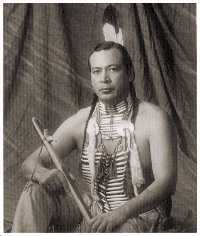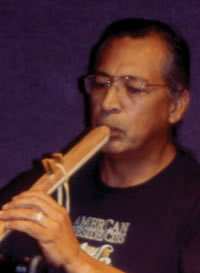The Spirit of the Flute
 I’m Keith Bear, I live on Ft. Berthold Reservation
I’m Keith Bear, I live on Ft. Berthold Reservation
I kind of started life as a Sioux boy and ended up being raised bi-culturally, Sioux Mandan with my mother and my relatives here, emphasizing the Mandan/Hidatsa part, and then in first grade, shortly before first grade I was placed in my first foster home and in 12 years of school, I lived in fourteen non-Indian homes, not including the relatives I was spending time with during vacations and holidays and things like that back home here. So, cultural diversity, I got a first-hand experience pretty much all my life.
I purchased my first flute through trade with Sonny Tate Navacloya from Oklahoma. We worked in the oil field together in Cody, Wyoming area and I watched him carving on a stick one day, and you don’t really interrupt people, you just kind of observe, and they want to tell you they’ll tell you. Finally, I saw it getting rounded and started to be complete so I thought it was a pipe. Oh no, he said, this is a flute and then he showed me the holes and popped the holes in there and by the end of that evening he was playing this, you know, kind of sour note but it made a little whistle and the next morning when I came into the quantzet, there was this beautiful, beautiful sound. I had seen flutes as a kid hanging on the walls or in bundles of our people up here, but they were medicine. We were told not to play with those things as children I finally got him to trade.
I carried it for two years and I would show it off and finally I decided I wanted to change my life for my family, my kids, cause I knew I had a drinking problem or drug problem then and I wanted to change.
I ended up in Flagstaff, Arizona and so I went up on a cinder cone behind our house and stayed up there for three days and three nights and brought myself down.
The wind blew through the flute the first night and made a kind of real low tone.
The second night the leaves of the little brush that was there and the grass would kind of sway over those holes and it sang a little bit.
That was kind of scary, but I believe in the spirit. I thanked them for being there and for comforting me with that song and then when I did come down, it took me about maybe a week of making a lot of ugly noises on that thing, but then I got my first song.
I learned that song and kind of expanded on it a little bit, kind of improvised it a little bit and started listening rather than trying to play the flute and pretty soon it just started to sing to me and it was fascinating because my fingers would be moving, my mind would be thinking something else, and here is this beautiful music coming out of this thing and I wonder where did that song come from, where did it go now. So, even now, you know, I have come a long way since that time and I’ve got three CDs out there that have done pretty good and I got a couple in the can and one more in my head. So you know it is pretty fascinating that these simple pieces of wood have so much life and it does so many things. As long as you honor that spirit I think it will take care of you and it has been my healing process. It’s really nice to have something culturally.
I’ve already been nominated for a Grammy and won a Nammy, and this is really, really humbling because I can’t read music and I’ve got to play and record with nine symphonies around the country. I recorded with the Grand Forks Symphony, St. Paul Chamber Orchestra, and the National Symphony out of Washington DC last year here, my most recent. That was awesome to stand with some of the best musicians in the world and have no idea what that piece of paper says in front of me as far as music.
I’m continuing to encourage people to listen to the music, to be a part of the music, and just enjoy the music whether they’re making it or listening to it. It’s a healing thing for the players as well as the listener. It’s a journeying thing in the mind and the heart of the player as well as the listener. So those flutes have a very beautiful spirit. We’re the heartbeat and we’re the breath for them and the spirit of that flute and that song and that person will come out as long as they believe. It’s amazing.
Keith Bear
 World-renowned flute player, Keith Bear (Hidatsa and Mandan), is from the Three Affiliated Tribes in Fort Berthold, North Dakota. He is the son of Christine and John Bear of the Nagadawi Clan and related to Chief Bullseye, the adopted father of Sacajawea. On his mother’s side, they are descendants of Chief Hairy Coat, and on his father’s side, to Turtles Sitting Bull. Keith is the father of eleven children, ages 32 to 5.
World-renowned flute player, Keith Bear (Hidatsa and Mandan), is from the Three Affiliated Tribes in Fort Berthold, North Dakota. He is the son of Christine and John Bear of the Nagadawi Clan and related to Chief Bullseye, the adopted father of Sacajawea. On his mother’s side, they are descendants of Chief Hairy Coat, and on his father’s side, to Turtles Sitting Bull. Keith is the father of eleven children, ages 32 to 5.
Keith plays the flute by ear and uses the flute to tell stories. His uncle, Carl, showed him how to make flutes by hand. He was also given the right to use porcupine quills on his flutes. Five of his children now make and play the flute. He has played music with orchestras all around the world and has numerous music awards. His CDs Makoche Masters, Echoes of Upper Missouri, People of the Willows, and Earthlodge were produced by Makoche Records. Native American Music nominated Earthlodge for Best Traditional Artist, Best Video, and Best Male Artist.
Also a storyteller, he feels that stories are not merely legends or fables, but living stories. His presentations include being a spokesperson for the National Education Association regarding Indian warriors and Indian leaders. Stories of all origins are told daily to his children and presently he is in the process of having a book of his children’s children’s stories published. Keith believes in race reconciliation and that all humans being were created by the same Creator, that all are part of the four nations and the four directions. Keith has grouped together with other fathers and grandfathers to create stories to help young men to cope with the reality of going to war and fighting battles and facing death. When children have problems he uses tricksters, spiders, and coyotes to relate to in stories. A storyteller for Amtrack, he dresses in Native American regalia.
Keith is also a pipe carrier and ceremonialist and belongs to the Buffalo Dance Society. His uncle Fred is the war bonnet and headdress maker for the tribe and Keith has learned this skill from him. He is knowledgeable in genealogy and can gauge artwork by its era. Keith once had the honor of acting in a movie. He has also worked with foreign film and documentary companies.
Keith Bear (Mandan)
PO Box 215
New Town, ND 58763
701-627-4542
